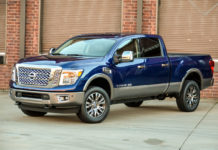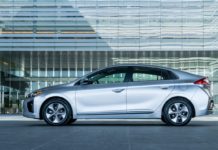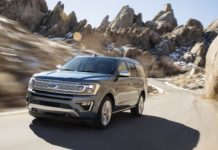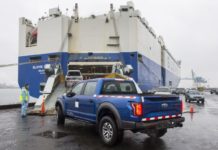JoAnn and Darryl Cook, a couple in upstate New York, waited eight weeks for the salsa red 2007 Toyota Tundra they ordered to arrive at a dealership near them.
Like many of the early buyers, the Cooks had a Toyota connection. They own a Matrix and traded in an older Tundra that were both trouble-free. They simply wanted a bigger truck, which Toyota delivered with the 2007 Tundra.
The Cooks are happy, but the new Tundra, among the most closely watched new vehicles this year, has had some hitches as Toyota challenges U.S. automakers in their strongest segment.
Toyota already is offering significant incentives and deflecting quality concerns, issues not usually associated with a vehicle launch by Toyota.
|
|
Yet sales are off to a strong start. Toyota sold 17,727 Tundras in May, more than double the number of the previous model.
“I felt like I was a king again driving that truck,” said JoAnn Cook, 66, a soft-spoken policy rater for an insurance agency. “I felt like if somebody got in my way, I could tell them to get out of my way.”
The '07 Tundra, Toyota's first true full-size truck, has been pitched as a pickup for true truckers, owners who depend on their trucks for hauling, towing and working.
Early data, though, suggest that Toyota loyalists have led the initial sales boost. If Toyota wants to reach its sales goal of 200,000 Tundras this year and expand on that number next year, the company will need to steal more customers from Ford Motor Co., General Motors Corp. and the Chrysler Group's Dodge, experts say.
Ambitious goal
Toyota is confident it can hit its goal, said Brian Smith, Toyota Motor Sales manager of truck and SUV marketing. Toyota's marketing campaign, which includes hundreds of events in local markets, is just warming up, he said.
“I will tell you that we're pleased with how the launch has gone,” Smith said. “I don't think any of us thought it was going to be a walk in the park.”
The Tundra launch has attracted attention and early criticism. Toyota had a limited supply of its largest 5.7-liter V8 engine at launch and was hampered by quality issues with some of those engines. About 30 out of 30,000 V8s had to be replaced because of faulty camshafts.
The engine problems have been addressed, Smith said. “We feel like it's very much under control, and barring some other type of new occurrences, which we haven't seen, I don't think you'll hear much more about it going forward,” he said.
Toyota, though, has challenges ahead. For the past three decades, Toyota has steadily increased U.S. sales, starting with small cars and moving up the chain to midsize sedans and luxury vehicles.
But Detroit owns the full-size pickup segment. Toyota's share of the segment, 9% in May, falls well short of GM's 42%, Ford's 31% and Dodge's 16%.
Five months into the launch, the picture is still forming on the type of consumer looking at the new Tundra, but the early buyers appear to be Toyota loyalists.
The leading buyer for the 2007 Tundra is the owner of a previous Tundra, with 23% of trade-ins for the April-through-June 10 period coming from owners of the old model, according to data from the Power Information Network. The Tundra, 4Runner, Camry and Tacoma combined account for more than 35% of all trade-ins.
But the Tundra is also taking customers from Ford and Dodge. Ford F-series trucks are the second-most traded-in vehicle for a Tundra at 10.5% of trade-ins, up from 7% for the same period a year ago. Dodge Rams, fourth on the list, account for 5.6% of trade-ins, up from 3.9%.
The Chevy Silverado and GMC Sierra represent 5.4% and 3.2%, respectively, of Tundra trade-ins, the same for the Silverado and up slightly for the Sierra from last year.
Ford and Dodge are susceptible to losses this year because they have older trucks, said Christopher Li, a research specialist for the Power Information Network. GM redesigned its trucks last year.
“The battle is going to keep going for the near future,” Li said. “I think you see that the squeeze is coming from the Ram and F-series area.”
Incentives war
Toyota's gains are coming at a cost. The automaker has significant incentives on the new Tundra. Dealers can offer up to $3,500 cash back or zero-percent financing for 60 months on the trucks.
The Tundra incentives are higher than offers by GM, about the same as Ford's incentives and below Dodge's deals, which provide as much as $6,000 in customer or bonus cash.
Unlike other segments where it has an established track record, Toyota is having to work hard to win converts, said Jesse Toprak, executive director of industry analysis for Edmunds.com. An incentives war will likely step up as the year wears on, he said.
“Toyota needs to give people a reason why they should check out a Tundra, other than just the Toyota name,” Toprak said.
Smith, head of Toyota truck marketing, said using incentives this soon is unusual for Toyota but the environment is difficult. Rising gas prices and a decline in new home construction have pushed down overall sales for full-size trucks.
Toyota, though, sees positive trends, he said. In a segment with high brand loyalty, Toyota has quickly captured customers from other brands, he said. Toyota also is getting more customers who own heavy-duty Ford, GM and Dodge trucks, more powerful versions than the basic half-ton. The Tundra does not have a heavy-duty version yet.
“We've had twice as many trades coming from heavy-duty trucks as previously with our last-generation Tundra,” Smith said. “So that capability message is clearly being recognized by consumers as well.”
Toyota believes its grassroots marketing campaign is reaching hardcore truck buyers, Smith said.
JoAnn Cook, the upstate New York Tundra buyer, was predisposed to buying a Toyota because of her experience with the Matrix and previous Tundra. She did not seriously consider a Ford, GM or Dodge truck.
“It's not that I wouldn't try one,” Cook said. “It's just that we've gotten accustomed to the Toyotas. We know they're good and we haven't had any problems with them.”
But many truck buyers feel the opposite. They have never visited a Toyota dealership before because the previous Tundra was only 7/8 ths the size of the competition.
To get their truck in front of these buyers, Toyota has launched an extensive campaign that borrows heavily from Scion, a lineup of small cars that relied on local events targeted at young buyers.
For the Tundra, Toyota has started a Prove It! Tour that's hitting festivals, fairs, lumber stores and outdoor supply outlets across the United States. The tour had almost 30 stops in May alone with about 30,000 people test-driving the new Tundra. More than half asked for additional information and to be contacted by a dealer, Smith said.
Toyota and its dealers also have dispatched smaller “street teams” to take the truck to places like construction sites where workers can test it on their lunch break.
Toyota, which started prepping dealers two years in advance of the launch, is confident these local efforts will translate into sales and sustain the Tundra's growth.
“It's going to come from the bottom up,” Smith said. “It's not going to come from a national ad.”









